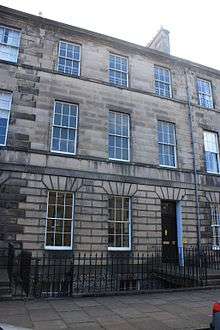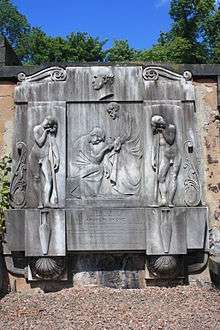Andrew Skene
Andrew Skene FRSE (1784–1835) was a Scottish advocate who rose to the highest level for his profession: Solicitor General for Scotland.[1]


Life
He was born in Aberdeen on 28 February 1784 the son of Prof George Skene of Rubislaw FRSE MD (1741-1803), Professor of Natural Philosophy at Marischal College[2] and Jane Moir of Stoneywood.[3]
In 1811 he was appointed Counsel for the City of Aberdeen in place of John Burnett Judge Admiral, for all legal matters in Scotland.[4]
In 1823 he was a co-founder of the Bannatyne Club along with his brother-in-law Sir Henry Jardine and Sir Walter Scott.
In 1829 he was elected a Fellow of the Royal Society of Edinburgh his proposer being Alexander Maconochie, Lord Meadowbank. He was elected Solicitor General for Scotland in 1834, replacing Henry Cockburn, Lord Cockburn.[5]
He lived at 74 Great King Street in Edinburgh's Second New Town[6] and died there on 2 April 1835, aged only 51. He is buried in New Calton Burial Ground on the east side of the city centre. The extremely fine marble monument was sculpted by Patric Park.
Family
There is sometimes confusion over the family of Andrew Skene and that of James Skene of Rubislaw.
James Skene was the youngest surviving child of George Skene of Rubislaw (1736-1776), an Aberdeenshire landowner and erstwhile lawyer, and Jean Skene (née Moir of Stoneywood) (1741-1820). They had seven children:
Margaret (born 1767), Helen (1768-1841), Catherine (1769-1838) who married Henry Jardine the, King's Remembrancer, George (1770-1791), and James (1775-1864) who inherited his father's estate at Rubislaw. Two daughters, Jean and Maria, did not survive infancy.
As a widow, Jean Skene moved to Edinburgh c. 1783 with her five remaining children. They lived at various addresses including Riddell's Court in the Old Town and George Street and South Castle Street in the New Town.,[7][8][9] Andrew Skene never married.
Artistic recognition
He was painted by Colvin Smith in 1835 during his role as Solicitor General. The painting is held by the National Gallery of Scotland.[10]
References
- Session, Scotland Court of (1 January 1835). "Cases Decided in the Court of Session". Bell & Bradfute – via Google Books.
- Johnson, Alexander W. S.; Aberdeen.), James Young (merchant burgess of (1 January 1860). "A short memoir of James Young, merchant burgess of Aberdeen, and Rachel Cruickshank, his spouse, and of their descendants [&c. Signed A.J.]". J. Craighead – via Google Books.
- "Archived copy" (PDF). Archived from the original (PDF) on 16 January 2014. Retrieved 29 June 2015.CS1 maint: archived copy as title (link)
- "The Scots Magazine ..." Sands, Brymer, Murray and Cochran. 1 January 1811 – via Google Books.
- Bulletins and Other State Intelligence. Compiled and arranged from the official documents published in the London gazette. 1834. p. 390.
- "(210) - Scottish Post Office Directories > Towns > Edinburgh > 1805-1834 - Post Office annual directory > 1832-1833 - Scottish Directories - National Library of Scotland".
- 'Memorials of the Family of Skene of Skene', New Spalding Club 1887, edited by William Forbes Skene (1809-1892), second son of James Skene of Rubislaw, and Royal Historiographer for Scotland.
- S. McKinnon, 'The Constant Traveller: James Skene of Rubislaw', Journal of the Scottish Society for Art History, Vol.19, 2014-2015, pp. 27–36 - White Cockade Publishing.
- Oxford Dictionary of National Biography online: James Skene of Rubislaw.
- CMS, Keepthinking-Qi. "Andrew Skene (1784–1835), Solicitor General for Scotland - Art UK Art UK - Discover Artworks Andrew Skene (1784–1835), Solicitor General for Scotland".